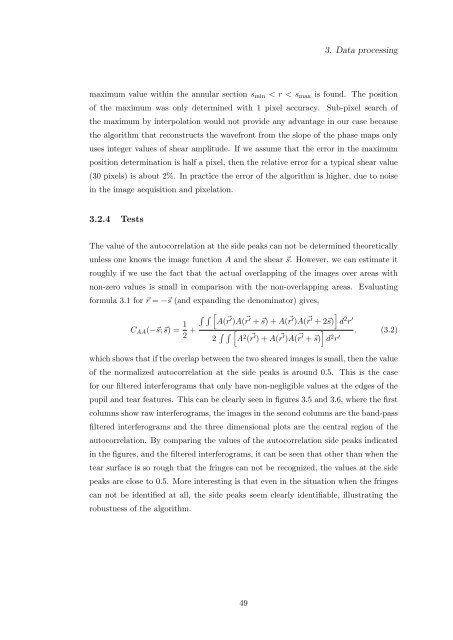Alfredo Dubra's PhD thesis - Imperial College London
Alfredo Dubra's PhD thesis - Imperial College London
Alfredo Dubra's PhD thesis - Imperial College London
Create successful ePaper yourself
Turn your PDF publications into a flip-book with our unique Google optimized e-Paper software.
3. Data processing<br />
maximum value within the annular section s min < r < s max is found. The position<br />
of the maximum was only determined with 1 pixel accuracy. Sub-pixel search of<br />
the maximum by interpolation would not provide any advantage in our case because<br />
the algorithm that reconstructs the wavefront from the slope of the phase maps only<br />
uses integer values of shear amplitude. If we assume that the error in the maximum<br />
position determination is half a pixel, then the relative error for a typical shear value<br />
(30 pixels) is about 2%. In practice the error of the algorithm is higher, due to noise<br />
in the image acquisition and pixelation.<br />
3.2.4 Tests<br />
The value of the autocorrelation at the side peaks can not be determined theoretically<br />
unless one knows the image function A and the shear ⃗s. However, we can estimate it<br />
roughly if we use the fact that the actual overlapping of the images over areas with<br />
non-zero values is small in comparison with the non-overlapping areas. Evaluating<br />
formula 3.1 for ⃗r = −⃗s (and expanding the denominator) gives,<br />
∫ ∫ [<br />
C AA (−⃗s; ⃗s) = 1 A( r ⃗′ )A( r ⃗′ + ⃗s) + A( r ⃗′ )A( ⃗ ]<br />
r ′ + 2⃗s) d 2 r ′<br />
2 + 2 ∫ ∫ [ A 2 ( r ⃗′ ) + A( r ⃗′ )A( r ⃗ ] , (3.2)<br />
′ + ⃗s) d 2 r ′<br />
which shows that if the overlap between the two sheared images is small, then the value<br />
of the normalized autocorrelation at the side peaks is around 0.5. This is the case<br />
for our filtered interferograms that only have non-negligible values at the edges of the<br />
pupil and tear features. This can be clearly seen in figures 3.5 and 3.6, where the first<br />
columns show raw interferograms, the images in the second columns are the band-pass<br />
filtered interferograms and the three dimensional plots are the central region of the<br />
autocorrelation. By comparing the values of the autocorrelation side peaks indicated<br />
in the figures, and the filtered interferograms, it can be seen that other than when the<br />
tear surface is so rough that the fringes can not be recognized, the values at the side<br />
peaks are close to 0.5. More interesting is that even in the situation when the fringes<br />
can not be identified at all, the side peaks seem clearly identifiable, illustrating the<br />
robustness of the algorithm.<br />
49

















